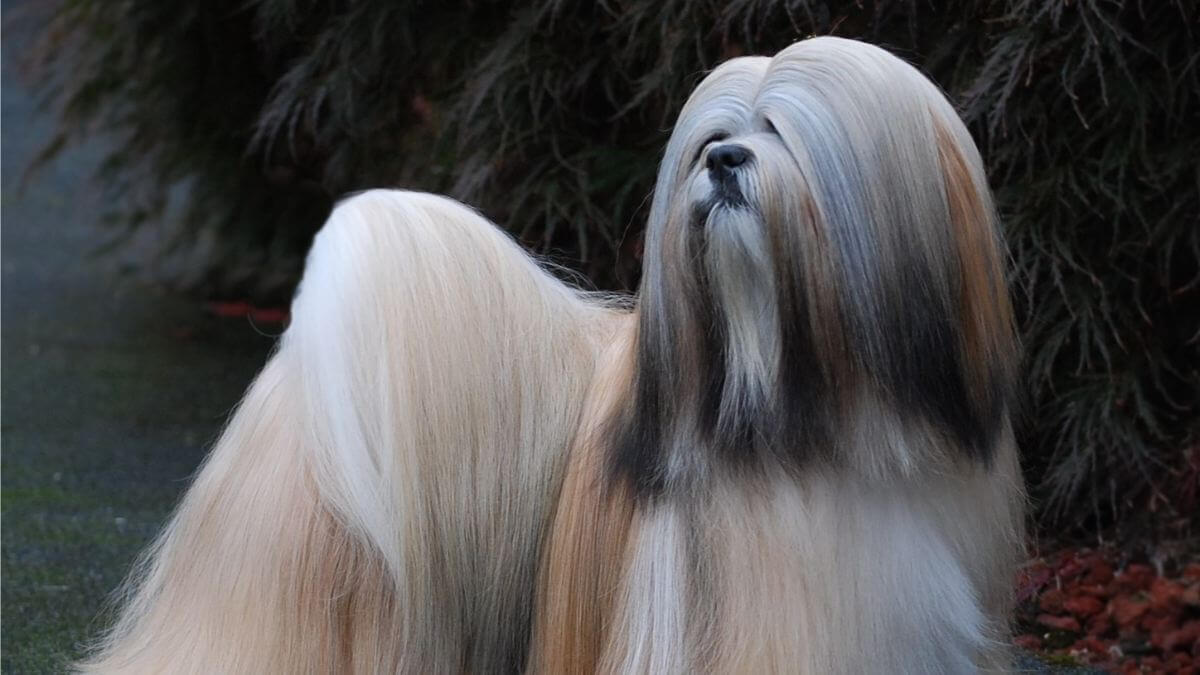


Home » Judging the Lhasa Apso

This article was originally published in Showsight Magazine, March 2014 issue.
As the saying goes, you can’t judge a book by its cover. And you can’t judge a Lhasa without putting your hands on the dog. A long-haired magnificently groomed glamorous dog may turn out to be simply that—what is under the coat is of great importance. The Lhasa originated in Tibet where the elevation is about 12,000 feet—far greater than most of us have experienced, but if you are familiar with the feeling of being unable to breathe due to altitude, you will understand that the Lhasa needs to be a sturdy mountain dog.
His structure must reflect an ability to traverse steep inclines. He is a rectangular dog, well ribbed up—meaning a longer ribcage to accommodate lung capacity needed at altitude. A strong loin is also required—again, suitable for the terrain of his country of origin. As with all Tibetan breeds, nothing about the Lhasa is inefficient or overdone or exaggerated. The Lhasa must be agile and is neither overly coarse nor overly refined. The overall look of the Lhasa is that of a well-balanced rectangular small (about 10-11″ tall) dog—neither too much back length but not square either. The neck rises smoothly from the shoulders and a long straight heavy coat on the head and body with a feathered tail over the back complete the picture.
This coat can be any color or combination of colors. Of course, puppies and youngsters will not have the coat length of the more mature dogs. Lhasas are judged on the table. Most judges will start by looking at the side view of the dog, and an exhibitor will appreciate a reasonable amount of time to get the dog prepared for examination. Always approach a Lhasa from the front—the head fall precludes peripheral vision, and Lhasas are chary (suspicious) of strangers. So a careful, slow approach is appreciated. Never examine the Lhasa on the ground. If you wish to re-examine an exhibit at any time, ask the handler to put the dog back up on the table. If you wish to compare two exhibits, both may be placed on the table, but never attempt to compare more than two at a time. Start your exam with the head by placing your hand under the muzzle.
Notice first the expression. Framed by the heavy head furnishings, a Lhasa possesses a soft but wise expression. This expression is achieved with a combination of a dark brown frontally placed medium-sized oval eye with minimal, if any, white visible, a muzzle ⅓ the length of the skull, and a black nose and eye rims. The skull is narrow, not quite flat, but neither domed nor apple-shaped. Ears are pendant and heavily feathered, and they are set near eye level. To evaluate the narrowness of the skull, gently push the hair toward the back of the skull. This allows you to evaluate the narrowness of the skull without the illusion of width created by the head fall. There should be a strong, but not prominent underjaw, with no indication of snipiness. The preferred bite is level or undershot. Breeders strive for a reverse scissors bite with sufficient width to accommodate full dentition. Most important is that the bite should not interfere with the correct expression for the breed.
Undesirable to the expression are large round bulgy eyes or close-set small beady eyes, lower teeth showing, down-faced muzzles, and muzzles that are too short or too long and snipy. To evaluate the front, run your hands down both front legs. The standard asks for straight forelegs. The vast majority of Lhasas will have a slight bow and the front feet will toe out slightly. The brisket is level to or slightly below the elbow and there is a prominent pro-sternum. If you place the palm of your hand between the front legs there should be a width of three or four fingers. Both front and rear assemblies of the Lhasa are that of a normal canine. For the front assembly, the length from the point of shoulder to elbow and the point of shoulder to withers are equal. Proper shoulder placement (well laid back) is essential for support, balance, and smooth transition from neck to topline. There should be only a slight (1-2 fingers) space between the shoulder blades. The neck should be strong and well proportioned. Run your hand along the neck to accurately determine where it flows into the shoulder.
Note the body length. It is measured from the point of shoulder to point of buttock and should be about one-third longer than the height at the withers. The standard calls for a well-ribbed up Lhasa and this is used to describe a long ribcage that will extend well back toward the loin area. This allows for the extra lung capacity desirable at higher altitudes. A Lhasa should be in good weight and be well-muscled. Younger Lhasas may display a tendency toward leanness as the breed is slow to mature. Check the topline as you examine the dog along with the tail set. The heavily feathered tail is set high enough to allow the tail to be carried well over the back in a screw or a curve. As you examine the body of the Lhasa, you may notice variations in coat texture.
The coat is ideally heavy, straight, and hard of good length. It is dense and is a double coat. When lifted from the body, a mature coat will fall back into place. When feeling the coat texture, rub the coat between your fingers to feel individual hairs. Puppies will have a tendency to have a softer coat and there are various stages of development of the coat. The coat first matures at the withers and eventually works its way back. Parti colors will have different textures in the white vs. colored portions of the coat. Many Lhasas do not have a fully mature coat until the age of 3 or 4. The length of coat need not be to the ground. It must be adequate for the purpose of protection from the elements. A cloak of hair, parted down the middle from nose to tail is certainly a magnificent sight—even more so when accompanied by correct structure and muscle tone.
Rear construction, as noted previously, is that of a normal canine. Hocks are perpendicular to the ground, and slightly behind the buttocks. Front and rear angulation should be equal and balanced. A light, but thorough exam of the Lhasa is needed. Yes, you may have to “rearrange” the coat a bit, but judges who fail to check for body length, condition, and muscle tone are doing the breed a disservice. Judging the Lhasa based solely on coat is an indication that a judge is not familiar with the breed. You may be rewarding the grooming rather than the dog. While the dog is still on the table, take the time to evaluate overall balance. Remember—longer than tall, moderate bone and body, neck flowing into shoulders, level topline. Now it’s time to send the dog around the ring. Will what you felt translate into the anticipated movement? Lhasas should move freely with good and balanced reach and drive.
When viewed going away, the pads of the rear feet should be evident—but never kicking up with exaggerated motion. When viewed coming toward you, the front feet contact the ground well forward with no tendency toward hackney or exaggerated lift. From the side, the Lhasa should cover ground with ease. The gait should be smooth and free-flowing without any hint of wasted action. The neck is strong and carries the head with an air of assertiveness. As the Lhasa increases its speed, there is a tendency for the head to be extended slightly toward the line of travel. The topline should be level and the tail must be carried over the back. The single fault mentioned in the standard is low carriage of stern.
While at rest, it is common for a Lhasa to hold his tail in the down position, but the tail must come up and over the back once the dog begins to move. No championship points should ever be awarded to a dog with its tail down. The Lhasa Apso is a gay and assertive dog and should move like one. There is nothing more glorious than a fully coated Lhasa Apso, carrying his head with an air of assertiveness, moving effortlessly and enthusiastically around the ring. The National Specialty for the American Lhasa Apso Club will be in St. Louis, MO, in October of 2014 and in Boston, MA, in October of 2015. Plan to attend the Judges’ Education program there. For information contact Bobbie Wood at anbara@comcast.net. Our Illustrated Guide, a list of breed mentors along with a brief video can be found on the ALAC website at lhasaapso.org.
